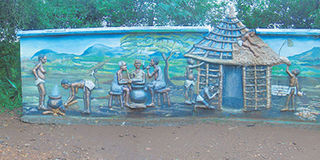History of the Luo

Kisumu Museum, built in the early 1980s hasn’t changed at all. Even the lion in a dramatic leap on the wildebeest is beginning to wear out. I remember the museum looking exactly the same as it did all those years ago.
Yet this one-room museum with an adjoining aquarium, snake park and a Luo homestead is interesting for it takes you back to the days of the good homestead.
A linguistic map of Kenya introduces the newcomer to Kenya’s diversity of peoples defined along linguistic groups, the main ones being the Cushites, Nilotes and Bantu.
The Luo belong to the Nilotic group which came down the River Nile through Sudan.
Being the most westerly branch, they morphed from pastoralists into agriculturalists and fishermen.
The Maasai, Samburu, El-Molo and Il-Camus are the plains Nilotes and traditionally pure pastoralists while the Kalenjin like the Nandi, Kipsigis and Tugen are the highland people and traditionally agro-pastoralists.
Each case shows a spectre of Luo life from the ceremonial gear to the earthen pots used; from the weapons of war to the bird traps; from the smoking pipes to the once-abundant diversity of animals.
Although the elephant is not showcased in the museum, the megaherbivore once roamed the lakeshores and traders from the coast stopped at ‘Kavirondo’ in the area that is now Kisumu to trade spices and cloth in exchange for elephant tusks.
The aquarium, a tad too dull, nevertheless has a few interesting species of the rare fish and eels found in the world’s second largest lake and one that was the greatest mystery to be solved in the 19th century – as the source of the River Nile flowing out from the lake and entering Egypt to drain into the Mediterranean Sea.
Outside on the grounds, huge murals depicit how life was back then. It shows Onyango, the man of the house, setting out to build his new homestead.
The murals relate how his uncle chooses the right position and drives a forked pole into the ground.
A bird trap is hung and a piece of the anthill placed at the door to protect the homestead from evil eyes and a cockerel slaughtered and served to the elders of the clan.
The most important feature of the new homestead was the gate, which was of symbolic significance besides being used for security.
It was through the gate that the men passed when they went to sow seeds and it was through the same gate they passed when the harvest was collected.
The gate had to be on lower ground so that all the rainwater could flow down and the homestead cleansed of debris.
A hornbill on the ground by the homestead stands innocently while people walk past. In days of old, and even today among die-hard traditionalists, the hornbill was believed to be a sign of bad omen while a hoot from the owl meant that someone was sure to die.
A woodpecker was just as unpopular and if one was heard on a journey, it would be terminated immediately to avoid bad luck befalling you.
A few fat and slitheringly long pythons lie at rest in their glass cases watched by curious onlookers. In 1988, a sensational case caught the attention of the media.
It centered on an enormous python found by the shores of the lake and called Omieri (or Omweri). Pythons are believed to bring good luck, especially if seen during times of drought and famine.
Unfortunately, poor Omieri sustained accidental burns when the villagers were clearing the land.
The snake was brought the Nairobi snake park in a high profile case with the community on one side demanding their snake back and the officials on the other side insisting that the snake needed urgent medical attention.
Meanwhile, Omieri lay coiled in its cage in Nairobi with hundreds of curious wananchi who knew nothing about snakes suddenly trooping to see the snake.
A cache of gabon vipers, beautifully patterned almost blending in with the litter of leaves, lie next to Omieri’s descendents, and are one of the most venomous snakes in the world.
Kisumu has an interesting history from the old travelers books. The Uganda Railway built between 1896 to 1901 terminated at Kisumu, giving it prominence as a port city.
Originally called Port Florence, it was renamed Kisumu from the word ‘sumo’ meaning a place to barter.




